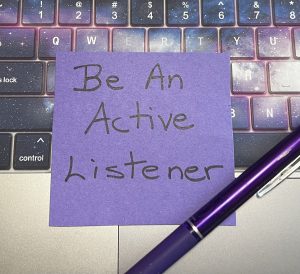4.2 Client Perspective
Meet people where they are at
When I worked in Supportive Housing in Toronto as a Housing Support Worker, I made a point of meeting the clients I worked with where they were comfortable. For some it was walking outdoors, sitting in a park, in the living room at the house they lived in, at our office and for some it was sitting in a coffee shop. I had the privilege to be able to be flexible and it made such a difference in the communications, conversation, topics and sharing of personal knowledge. I was always aware of the topics and conversation, but first of all I was aware of who I was with and allowed them to make decisions of where we met and what we talked about. We don’t always have that as an option … But think about what you could do in the role that you have to make the client feel comfortable, heard or safe. Denise Halsey
We partner with our clients and focus not only on the content of what we talk about, but also on the person, their process, their challenges and concerns. It is important to remember that the client is the expert in their life and journey. We are along for the journey as they have decided to invite us along.
It’s important to always consider your clients’ perspectives. The clients’ perspective is often the most overlooked aspect in many encounters or businesses. It’s important to be able to see the clients’ perspective through their eyes so that we can join them on the journey with them, remembering it is a partnership.
Our society so often focuses on our own needs, and not always on others. It’s important to focus on your client so we can be the most effective in assisting them with whatever brought them to us. There are so many options and choices and assisting them in finding options that work for them is very important.
When a client comes for assistance they already see many roadblocks in front of them and part of our journey with them is assisting in finding options for these roadblocks, so they can use their voice and have choices/options that are not only realistic and obtainable, but are purposeful for the client.

By assisting and defining goals and options your clients needs mindset can change and opportunities seem possible.
The goals for each client that we work with are as varied as the dilemmas our clients struggle with. A systematic approach to the exploration of issues can go a long way in effectively addressing what is brought to the table and, most of all, in getting to know the person who brings them, connect with them and work on solutions to each of these challenges.
What is the problem from their point of view?
Clients come in with unique perspectives on what the problem is and sometimes with what the solution to that problem should be. They are aware there is a problem which is what brought them to us.
The goal is to make the client feel acknowledged, heard, supported and accepted for who they are, and for that, caution and patience are required. Empathic, nonjudgmental Active Listening is crucial.
Active Listening

How to Listen to Understand
Watch this video on 5 ways to listen better – Julian Treasure
5 ways to Listen Better. TedTalk. In our louder and louder world, says sound expert Julian Treasure, “We are losing our listening.” In this short, fascinating talk, Treasure shares five ways to re-tune your ears for conscious listening — to other people and the world around you.
Transcript

Active listening is a very important skill that is necessary to MI. It is something that we need to be mindful of to practice and be present to actually hear what the person is saying. There is a skill to reflective listening and although it is a basic skill, it is a critical skill for the 4 process of MI. It does take time and practice to become skillful in active listening. Active listening is a critical skill when being client-centred.
There are many different roadblocks that we use everyday without realizing how it shuts down communications vs active listening. Dr. Thomas Gordon created 12 Roadblocks to communications that people commonly give to each other, when they are not listening.
It’s important to be aware of your Active Listening Skills and work on them to be effective in communicating. Things that can challenge our Active Listening Skills can be as simple as our body language, interrupting the other person, giving advice, not making eye contact, fidgeting, withdrawing, and talking at someone vs talking with them are just a few to consider.
It is important to create positive changes without the client feeling hurried or being worked on.
- What brought you here today?
- Can you tell me a bit about yourself?
- How do you see the problem?
- How would you define the biggest challenge you’re facing right now?
- What are the things or people in your life that are causing challenges for you?
BE AWARE OF:
- Stage of Change (where they are, realizing they could be in several different stages i.e. not willing to take action on something & ready for taking action on something else.
- Biopsychosocial Plus (intersectionality)
- Solution Focused Counselling (SFBT) is typically very brief (three to five sessions), focuses on finding solutions, and attends only minimally to defining or understanding the presenting problems (De Shazer et al., 1986).
- Motivational Interviewing Skills
Questions that you can use:
- What brought you here today? (if they can have them list them for you)
- What stage of change are they in? (remember they can be in different changes with their challenges)
Questions for you to reflect on:
- Am I the answer the this challenge (sometimes we need to make referrals to someone else in our agency or to another agency – i.e trauma counselling)?
- My communication skills
- Do you connect with this community?
- Do I need more training?
When we are talking from a consumer perspective it should reflect more than just one voice or one experience that they have had. When we do that then we can get a clearer picture when we are talking about mental health and addictions.
Everyone’s journey is very specific to them.
What do Clients want?
- to be an active participant of the process
- to be heard
- good communication – ongoing
- to know what their options are
Exercises – Active Listening
Create a list:
- Roadblocks that you have been on the receiving end and how you felt about it
- Roadblocks you’ve seen others use
- Roadblocks you use and what can you do to change that
6 Tips for Active Listening by Spunout. Based on the Samaritans guidelines for active listening, SpunOut.ie presents 6 easy tips on how to actively listen, and support a friend or loved one while helping them thorough a tough time.
Brené Brown on Empathy. By: RSA. What is the best way to ease someone’s pain and suffering? In this beautifully animated RSA Short, Dr Brené Brown reminds us that we can only create a genuine empathic connection if we are brave enough to really get in touch with our own fragilities.
12 Roadblocks to Communications with a Client
- client-centred practices
- client is the expert in their journey
- Biopsychosocial Plus
- Solution Focused Counselling
- Motivational Interviewing
- sociocultural barriers
- Cultural Competence
- personal autonomy
- costs
- privacy
- confidentiality
For More Information:
TED. (2011, July 29). 5 ways to listen better | Julian Treasure [Video]. YouTube. https://www.youtube.com/watch?v=cSohjlYQI2A
spunout. (2015, October 4). 6 Tips for Active Listening #LittleThings [Video]. YouTube. https://www.youtube.com/watch?v=oWe_ogA5YCU
RSA. (2013, December 10). Brené Brown on Empathy [Video]. YouTube. https://www.youtube.com/watch?v=1Evwgu369Jw
What do Clients want?
- to be an active participant of the process
- to be heard
- good communication – ongoing
- to know what their options are

